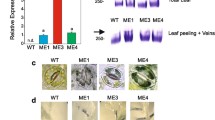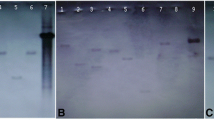Abstract
Proline metabolism has been proposed to play an important role in activating the shikimic acid pathway for increased secondary metabolites production in plants. Here we evaluated the role of proline per se and in combination with water deficit on the production of phenolic compounds in leaves of transgenic tobacco plants (Nicotiana tabacum) with increased proline content. For this, an experiment was carried out under greenhouse conditions using three genotypes (transgenic events E1 and E2 constitutively expressing the mutant gene VaP5CSF129A and an untransformed control) and two levels of water regimes (100% and 30% of soil field capacity). Total phenolics, proline, activities of glucose-6-phosphate dehydrogenase (G6PDH) and phenylalanine ammonia-lyase (PAL), and lignin were measured in the leaves. As expected, a reduction in biomass was observed in all genotypes under drought conditions and the maximum accumulation of proline occurred in transgenic plants in both water regimes. Under irrigated conditions, phenolics were only slightly superior in leaves of the transgenic event E2, while both events presented a noticeable increment in total phenolics and PAL activity under water deficit. Lignin biosynthesis also increased in all genotypes in response to drought stress, but it was more noticeable in the transgenic plants. On the other hand, the activity of the G6PDH enzyme was consistently lower in the transgenic plants in both irrigated and water-deficit condition. Our results do not confirm the association between de novo proline synthesis and the stimulation of G6PDH to produce phenolics.




Similar content being viewed by others
References
Al-Amier H, Mansour BMM, Toaima N, Korus RA, Shetty K (1999) Tissue culture-based screening for selection of high biomass and phenolic-producing clonal lines of Lavender using Pseudomonas and azetidine-2-carboxylate. J Agric Food Chem 47:2937–2943
An C, Mou Z (2011) Salicylic acid and its function in plant immunity. J Integr Plant Biol 53:412–428
Bates L, Waldren RP, Teare ID (1973) Rapid determination of free proline for water-stress studies. Plant Soil 39:205–207
Bezerra Neto E, Barreto LP (2006) Análises bioquímicas e físico-químicas em pós-colheita. In: Oliveira SMA et al (eds) Patologia pós-colheita: frutas, olerícolas e ornamentais tropicais. EMBRAPA, Brasília, pp 441–472
Bhaskara GB, Yang TH, Verslues PE (2015) Dynamic proline metabolism: importance and regulation in water limited environments. Front Plant Sci 6:484
Borgo L, Marur CJ, Vieira LGE (2015) Effects of high proline accumulation on chloroplast and mitochondrial ultrastructure and on osmotic adjustment in tobacco plants. Acta Sci Agron 37:191–199
Boudet AM (2007) Evolution and current status of research in phenolic compounds. Phytochem 68:2722–2735
Bradford MM (1976) A rapid and sensitive method for the quantitation of microgram quantities of protein utilizing the principle of protein-dye binding. Anal Biochem 72:248–254
Castiglia D, Cardi M, Landi S, Cafasso D, Esposito S (2015) Expression and characterization of a cytosolic glucose-6-phosphate dehydrogenase isoform from barley (Hordeum vulgare) roots. Protein Expr Purif 112:8–14
Chen YK, Li XS, Yang GY, Chen ZY, Hu QF, Miao MM (2012) Phenolic compounds from Nicotiana tabacum and their biological activities. J Asian Nat Prod Res 14:450–456
Cheynier V, Comte G, Davies KM, Lattanzio V, Martens S (2013) Plant phenolics: recent advances on their biosynthesis, genetics, and ecophysiology. Plant Physiol Biochem 72:1–20
Dal Santo S, Stampfl H, Krasensky J, Kempa S, Gibon Y, Petutschnig E, Rozhon W, Heuck A, Clausen T, Jonak C (2012) Stress-induced GSK3 regulates the redox stress response by phosphorylating glucose-6-phosphate dehydrogenase in Arabidopsis. Plant Cell 24:3380–3392
Dobra J, Motyka V, Dobrev P, Malbeck J, Prasil IT, Haisel D, Vankova R (2010) Comparison of hormonal responses to heat, drought and combined stress in tobacco plants with elevated proline content. J Plant Physiol 167:1360–1370
Fan L (2006) Progressive inhibition by water deficit of cell wall extensibility and growth along the elongation zone of maize roots is related to increased lignin metabolism and progressive stelar accumulation of wall phenolics. Plant Physiol 140:603–612
Fichman Y, Gerdes SY, Kovács H, Szabados L, Zilberstein A, Csonka LN (2015) Evolution of proline biosynthesis: enzymology, bioinformatics, genetics, and transcriptional regulation. Biol Rev 90:1065–1099
Gill SS, Tuteja N (2010) Reactive oxygen species and antioxidant machinery in abiotic stress tolerance in crop plants. Plant Physiol Biochem 48:909–930
Gitz DC, Lui-Gitz L, Mcclure JW, Huerta AJ (2004) Effects of PAL inhibitor on phenolic accumulation and UV-B tolerance in Spirodela intermedia (Koch.). J Exp Bot 55:919–927
Hare PD, Cress WA, Vanstaden J (2001) Disruptive effects of exogenous proline on chloroplast and mitochondrial ultrastructure in Arabidopsis leaves. S Afr J Bot 68:393–396
Hong Z, Lakkineni K, Zhang Z, Verma DPS (2000) Removal of feedback inhibition of delta−1- pyrroline-5-carboxylate synthetase results in increased proline accumulation and protection of plants from osmotic stress. Plant Physiol 122:1129–1136
Hura T, Hura K, Grzesiak S (2008) Contents of total phenolics and ferulic acid, and PAL activity during water potential changes in leaves of maize single-cross hybrids of different drought tolerance. J Agron Crop Sci 194:104–112
Hura T, Hura K, Dziurka K, Ostrowska A, Bączek-Kwinta R, Grzesiak M (2012) An increase in the content of cell wall-bound phenolics correlates with the productivity of triticale under soil drought. J Plant Physiol 169:1728–1736
Hura T, Hura K, Ostrowska A, Grzesiak M, Dziurka K (2013) The cell wall-bound phenolics as a biochemical indicator of soil drought resistance in winter triticale. Plant Soil Environ 59:189–195
Jaleel CA, Manivannan P, Wahid A, Farooq M, Al-Juburi HJ, Somasundaram R, Panneerselvam R (2009) Drought stress in plants: a review on morphological characteristics and pigments composition. Int J Agric Biol 11:100–105
Kaur G, Asthir B (2015) Proline: a key player in plant abiotic stress tolerance. Biol Plantarum 59:609–619
Keles Y, Oncel I (2002) Response of antioxidative defence system to temperature and water stress combinations in wheat seedlings. Plant Sci 163:783–790
Kishor PBK, Sangam S, Amrutha RN, Laxmi PS, Naidu KR, Rao KRS, Rao S, Reddy KJ, Theriappan P, Sreenivasulu N (2005) Regulation of proline biosynthesis, degradation, uptake and transport in higher plants: its implications in plant growth and abiotic stress tolerance. Curr Sci 88:424–438
Kohl DH, Schubert KR, Carter MB, Hagedorn CH, Shearer G (1988) Proline metabolism in N2-fixing root nodules: energy transfer and regulation of purine synthesis. Proc Natl Acad Sci USA 85:2036–2040
Kwok D, Shetty K (1998) Effects of proline and proline analogs on total phenolic and rosmarinic acid levels in shoot clones of thyme (Thymus vulgaris L.). J Food Biochem 22:37–51
Landi S (2016) Glucose-6-phosphate dehydrogenase plays a central role in the response of tomato (Solanum lycopersicum) plants to short and long-term drought. Plant Physiol Biochem 105:79–89
Lattanzio V, Lattanzio VMT, Cardinali A (2006) Role of phenolics in the resistance mechanisms of plants against fungal pathogens and insects. In Imperato F (ed) Phytochem: advances in research, Research Signpost: Trivandrum, India, pp. 23–67
Lattanzio V, Cardinali A, Ruta C, Fortunato IM, Lattanzio VM, Linsalata V, Cicco N (2009) Relationship of secondary metabolism to growth in oregano (Origanum vulgare L.) shoot cultures under nutritional stress. Environ Exp Bot 65:54–62
Lee BR, Kim KY, Jing WJ, Avice JC, Ourry A, Kim TH (2007) Peroxidases and lignification in relation to the intensity of water-deficit stress in white clover (Trifolium repens L.). J Exp Bot 58:1271–1279
Lee BR, Zhang Q, Kim TH (2014) Lignification in relation to the influence of water-deficit stress in Brassica napus. J Korean Soc Grassl Forage Sci 34:15–20
Liang X, Zhang L, Natarajan SK, Becker DF (2013) Proline mechanisms of stress survival. Antioxid Redox Signal 19:998–1011
Maeda H, Dudareva M (2012) The shikimate pathway and aromatic amino acid biosynthesis in plants. Annu Rev Plant Biol 63:73–105
Malavolta E, Vitti GC, Oliveira SA (1997) Avaliação do estado nutricional das plantas: princípios e aplicações. Potafos, Piracicaba
Miller G, Honig A, Stein H, Suzuki N, Mittler R, Zilberstein A (2009) Unraveling delta1-pyrroline-5-carboxylate-proline cycle in plants by uncoupled expression of proline oxidation enzymes. J Biol Chem 284:26482–26492
Moura JCMS, Bonine CAV, Viana JOF, Dornelas MC, Mazzafera P (2010) Abiotic and biotic stresses and changes in the lignin content and composition in plants. J Integr Plant Biol 52:360–376
Pandey A, Rajamani U, Verma J, Subba P, Chakraborty N, Datta A, Chakraborty S, Chakraborty N (2010) Identification of extracellular matrix proteins of rice (Oryza sativa L.) involved in dehydration-responsive network: a proteomic approach. J Proteome Res 9:3443–3464
Pospisilova J, Haisel D, Vankova R (2011) Responses of transgenic tobacco plants with increased proline content to drought and/or heat stress. Am J Plant Sci 2:318–324
Ramakrishna A, Ravishankar GA (2011) Influence of abiotic stress signals on secondary metabolites in plants. Plant Signal Behav 6:1720–1731
Rattan RS (2010) Mechanism of action of insecticidal secondary metabolites of plant origin. Crop Prot 29:913–920
Rivero RM, Ruiz JM, Garcia PC, Lopez-Lefebre LR, Sanchez E, Romero L (2001) Resistance to cold and heat stress: accumulation of phenolic compounds in tomato and watermelon plants. Plant Sci 160:315–321
Sarkar D, Shetty K (2014) Metabolic stimulation of plant phenolics for food preservation and health. Annu Rev Food Sci Technol 5:395–413
Sarkar D, Bhowmik PC, Kwon YI, Shetty K (2011) The role of proline-associated pentose phosphate pathway in cool-season turfgrasses after UV-B exposure. Environ Exp Bot 70:251–258
Shetty K (1997) Biotechnology to harness the benefits of dietary phenolics, focus on Lamiaceae. Asia Pac J Clin Nutr 6:162–171
Shetty K (2004) Role of proline-linked pentose phosphate pathway in biosynthesis of plant phenolics for functional food and environmental applications: a review. Process Biochem 39:789–803
Shetty K, Mccue P (2003) Phenolic antioxidant biosynthesis in plants for functional food application: integration of system biology and biotechnological approaches. Food Biotechnol 17:67–97
Shetty K, Wahlqvist M (2004) A model for the role of the proline-linked pentose-phosphate pathway in phenolic phytochemical bio-synthesis and mechanism of action for human health and environmental applications. Asia Pac J Clin Nutr 13:1–24
Singleton VL, Rossi JA (1965) Colorimetry of total phenolics with phosphomolybdic-phosphotungstic acid reagents. Am J Enology Vitic 16:144–158
Szabados L, Savoure A (2010) Proline: a multifunctional amino acid. Trends Plant Sci 15:89–97
Terzi R, Güler NS, Çaliskan N, Kadioglu A (2013) Lignification response for rolled leaves of Ctenanthe setosa under long-term drought stress. Turkish J Biol 37:614–619
Van Soest PJ (1967) Development of a comprehensive system of feed analysis and its application to forage. J Anim Sci 26:119–128
Yaish MW (2015) Proline accumulation is a general response to abiotic stress in the date palm tree (Phoenix dactylifera L.). Genet Mol Res 14:9943–9950
Yang R, Shetty K (1998) Stimulation of rosmarinic acid in shoot cultures of oregano (Origanum vulgare) clonal line in response to proline, proline analog and proline precursors. J Agric Food Chem 46:2888–2893
Yang L, Wang CC, Guo WD, Li XB, Lu M, Yu CL (2006) Differential expression of cell wall related genes in the elongation zone of rice roots under water deficit. Russ J Plant Physiol 53:390–395
Zhang CS, Lu Q, Verma DPS (1995) Removal of feedback inhibition of delta-1-pyrroline-5-carboxylate synthetase, a bifunctional enzyme catalyzing the first 2 steps of proline biosynthesis in plants. J Biol Chem 270:20491–20496
Zucker M (1965) Induction of phenylalanina deaminase by light and its relation to chlorogenic acid synthesis in potato tuber tissue. Plant Physiol 40:779–784
Acknowledgements
We are grateful by the suggestions provided by Prof. Marilice Zundt Astolphi in the lignin analysis. FLBS and DN were supported by scholarships from Coordination for the Improvement of Higher Education Personnel (CAPES) and Brazilian National Council for Scientific and Technological Development (CNPq), respectively. LGEV is supported by a research fellowship from CNPq.
Author information
Authors and Affiliations
Corresponding author
Ethics declarations
Conflict of interest
The authors declare no competing financial interest.
Rights and permissions
About this article
Cite this article
Silva, F.L.B., Vieira, L.G.E., Ribas, A.F. et al. Proline accumulation induces the production of total phenolics in transgenic tobacco plants under water deficit without increasing the G6PDH activity. Theor. Exp. Plant Physiol. 30, 251–260 (2018). https://doi.org/10.1007/s40626-018-0119-0
Received:
Accepted:
Published:
Issue Date:
DOI: https://doi.org/10.1007/s40626-018-0119-0




